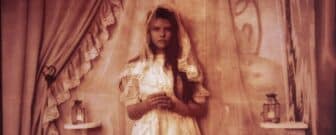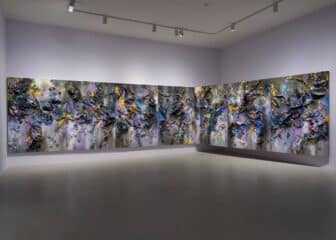
Radical Occupation, Strategic Trespass: Candida Alvarez’s Painterly Disorientations

Candida Alvarez’s exuberant, critically informed studio practice shows her as a visionary placemaker in search of capacities for belonging that work the vestiges of material and political life toward ways of inhabiting place that resist regulated definition. Across decades, Alvarez has absorbed and reacted to the cultural convulsions around painting—enlisting collage, drawing, assemblage constructions, embroidery, and mixed-media approaches to pattern-making, systems, and abstracted form as a means of continual expansion and invention. Refusing the kinds of partitions that would position abstraction as oppositional to representation, she has instead insisted on a kind of paradoxical play that neither fully reifies nor resists, integrates nor separates. So when the artist was approached in November 2016 by the Japanese fashion brand Comme des Garçons to collaborate on textile prints based on her paintings, designer Rei Kawakubo’s reference to Alvarez’s formal sensibilities as “new camouflage” offered a provocative yet apropos framework with which to consider how her approaches to the projects of abstraction and painting might be understood as they circulate through broader sociopolitical contexts. 1 This essay therefore explores ways that select paintings can be read as a complexity of tactics for assimilation, defense, and infiltration.

Camouflage, as it is conceptualized today, may be traced back to principles observed in natural history and the study of animal behavior, which were subsequently transposed into fabric patterning, like the ubiquitous Engineer Research & Development Laboratories (ERDL) camo, comprising interlocking organic shapes developed by the United States Army in the years directly following World War II, or the more recent algorithm-derived fractal camouflages. More painterly, flamboyant treatments of camo—such as the well known dazzle painting used on sea vessels in World War I onward, and Andy Warhol’s late-1980s, ironically conspicuous renditions of the ERDL pattern in outrageous, queer-coded color stories—enrich a contentious discourse around the siting and perceptions of bodies. This context informs the present inquiry into the ways that Candida Alvarez’s paintings similarly generate lively formal investigations into the politics of visibility (and invisibility), spatiality, and agency within a landscape delineated by power and transgression.
In a 2020 conversation with The Brooklyn Rail, Alvarez spoke in much the same manner as she paints, nimbly grafting into condensed form numerous outsized considerations of the ways the field of art has been taxonomized, the ways cultural and national identities are maintained, and the ways a self interacts with context:
So for me, painting became the park I can escape to and contemplate. But the ’80s also brought a lot of conversation about what representation was and what abstraction was. Those territories, those regions, classifications, those ways of thinking about work, were really strong… I always felt that I embodied my own politics, it was me making the choices that I needed to make in order to make sure that my imagination was safeguarded… My parents were really clear about who they were: they were Americans here, but Puerto Ricans at heart. I remember very specifically them telling me, ‘You are Puerto Rican,’ so we learned the culture, we ate, slept, and danced the culture, with salsa music at the core. I just knew I embodied something that was bigger than me. It gives me a reference point to always be myself.2
It’s my hope to propose ways in which Alvarez’s accounts of personal history and studio production can be understood as addressing the more complex systemic mechanisms of power through which artists and artworks circulate. The tactics of abstraction which she so deftly employs invite projections of multivalent conceptions of spaces and their navigation—not least of all ways of apprehending the ongoing disorientation of Puerto Rico’s standing as an unincorporated territory–commonwealth—itself a political and economic abstraction. With productive equivocality she devises a means of “escape” from “those territories, those regions”—inclusive of colonial geographies as well as the limitations and pressures endemic to the immigrant experience—by using an approach to painting that “embodied something that was bigger.” Informed by an intricate history of painting that extends far, wide, and up to the present, one might ascribe to Alvarez’s work a potent scrutiny of Abstract Expressionism’s rhetoric that read “gesture” as continuous with an individualist position. The action of mark-making in Alvarez’s paintings can instead be located within a gregarious field of sampling, citation, and collective meaning-making by which a populist, pluralist stance is produced. Layering stream-of-consciousness personal associations with de and re-contextualized cultural fragments, Alvarez’s formal vocabulary operates as a device of translation across multiple realms, shaped as much by her family’s diasporic trajectories and the phenomenology of her childhood in a Brooklyn high-rise housing project as the multifarious roles abstraction came to play in the succession of Pop Art, Conceptualism, and the criticality of postmodern returns to painting. Alvarez organizes abstract forms against these intricate structures, emphasizing a positionality through devices of proximity and distance, surface and implied imbrications, precisely articulated contours and even more strategic transgressions of those borders.
Her canvas Clear (2023), is plotted with a field of brightly colored, interlocking organic shapes with relatively defined edges in the fluid-matte finish of Flashe, a vinyl paint here combined with paint pen inscriptions on a sweeping linen surface. Clear proceeds from a longstanding fascination the artist has described with paint-by-number crafts, the “new world you’ve created” by “following the instructions” and “filling in the colors.”3 In an interview coinciding with Clear’s first exhibition, the artist described part of her process for this particular body of work: “There’s this element of travel, moving with your ideas and your work to different spaces.”4 While in no way literal or directly cited, one could associate these markers of travel and space-making in Clear with cartographic traditions that treat the congested field of tinted sunset pastels and heartland verdancy as flyover mapping. Approached thus, Clear shifts further into abstract fantasia—a meltdown of modality exercised in fraught depictions of the nation-state like Jaune Quick-to-See Smith’s Memory Map works and LA conceptual painter Kim Dingle’s Map works of the 1990s, not to mention Jasper Johns’ many Map paintings that loosen the US territory into an expressionistic-yet-calculated firework display in Fruit Loop primary hues. Alvarez maps instead her contemplative escape aforementioned into a dreamworld freed of colonial claims and commonwealth subjugations, wherein greens and pinks and periwinkles gesture equally toward earth and sky, a looking outward toward a painted canvas that prismatically bends into looking up, down, and inward—a vigilant inquisitiveness directed toward the interrelatedness of things. A key feature of Clear are the places where its vibrant shapes don’t quite meet, and patches of the bare linen show through. This gentle instability is reinforced by the wavering shimmer of bronze and grey metallic pigments close in tone and hue to the linen itself, yet glittering like drifting mirages to serve as a witty, wise reminder that the hubristic power plays of delineated territory and governance belie underlying continental drift and further tectonic rupture.
While Clear expands on the pictorial possibilities of apprehending place, Alvarez’s large Air Paintings from 2017–19 further intervene into the demarcation and occupation of space by moving away from the preexisting architecture of exhibition environments, displayed instead as two-sided paintings on PVC mesh held in suspension from freestanding aluminum frames. The early, partially obscured underpainting layers of one such work, Here to There (2018), bear resemblance to the way Clear has been compositionally divided into sectors with shapes abutted against one another.
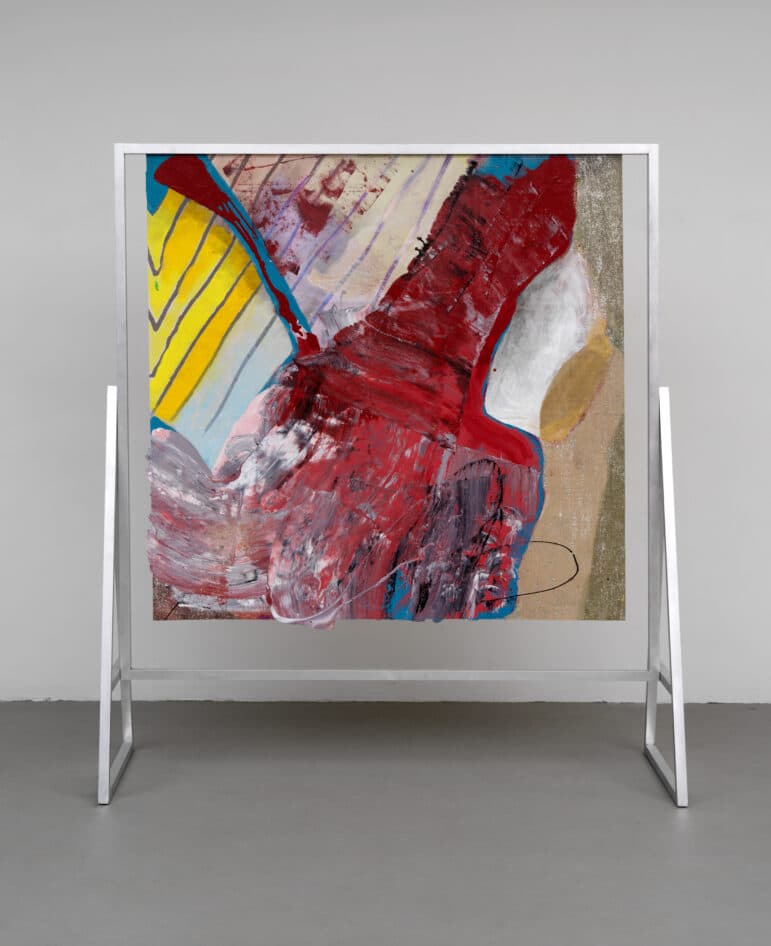
Latex ink, acrylic, enamel, and glitter on PVC mesh with aluminum and wood, 81 x 71 x 26 inches. Image courtesy of the artist and Monique Meloche Gallery.
Subsequent accretions in acrylic, latex, and enamel rush across the hanging surface in muscular crimson swoops, ropey splatters, and even puddling that exceeds the edges of the rectangle. Here to There is a rhapsody of assertions—starting with the shift of the painting to function as a division of space, viewable from multiple sides and vantages, and further accentuated with passages of glitter, stirring clashes of color, and a range of gestural mark-making that records artifacts of a body in action.
The restless energy in Here to There is not only telegraphed to its verso side in crackles of caution yellow, shafts of opalescent grey-pink, blobs of terracotta brown, and sedimented layers of rainbows in decomposition, but also charges the painting as an object in space, anticipatory of its circulation not as an image on a wall but as a direct intervention into the social.
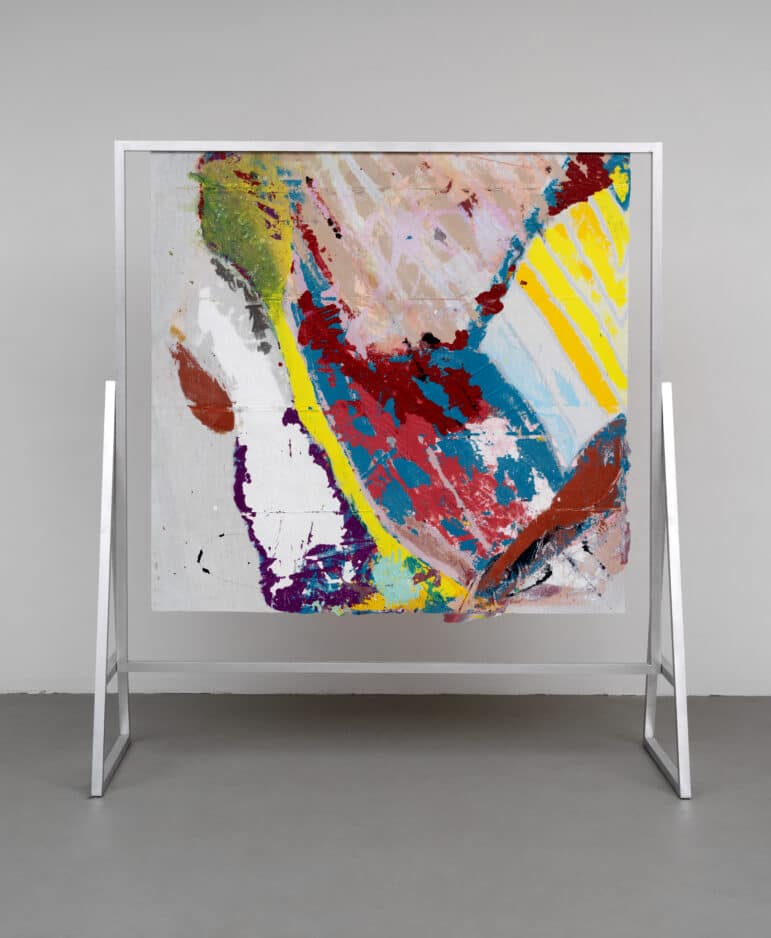
When Alvarez arrays shapes whose edges don’t quite meet, stains that pass through barriers and partitions, and color that optically unsettles, she is organizing the building blocks of painting and abstraction toward a refusal of the kinds of controls exerted by colonialism, territorialism, and with them, the uneven power relations of the project of modernism per se. The effects of the formal devices Alvarez wields may be read as proximal to Kobena Mercer’s notion of “discrepant abstraction,” her “obstinate and strange…point of intervention is to question the forms of closure that have, until recently, limited our understanding of abstraction’s multiple and entangled histories.”5 In these ways, rather than stake out claimed space within the coalitional—if not collective—project of abstraction, Alvarez breaches the zoned geopolitical landscape and the aesthetic fields with which it conspires, navigating with a resolved uncertainty oriented toward radical occupation, strategic trespass, and a categorical skepticism directed toward the existence and efficacies of borders outright. Gloria Anzaldúa writes of this kind of abstracting away from maintained borders: “She has discovered that she can’t hold concepts or ideas in rigid boundaries…she operates in a pluralistic mode—nothing is thrust out, the good the bad and the ugly, nothing rejected, nothing abandoned. Not only does she sustain contradictions, she turns the ambivalence into something else.”6 As Alvarez herself noted, she is concerned with a form of embodiment that is bigger than the individual—extending beyond the conventions of colonized, camouflaged, assimilated, into a dynamic “something else”—synthetic, sympathetic, and engaged across ever-shifting grounds.
- Anna Marevska, “Comme des Garçons Spring 2017 Men’s Collection Features a Chicago Artist’s Print,” Fashion Files, February 1, 2017, https://fashionfilesmag.com/comme-des-garcons-candida-alvarez. ↩︎
- Candida Alvarez, “In Conversation with Phong Bui,” The Brooklyn Rail, March 2020, https://brooklynrail.org/2020/03/art/CANDIDA-ALVAREZ-with-Phong-H-Bui. ↩︎
- Alvarez, “In Conversation with Phong Bui.” ↩︎
- Candida Alvarez, “Virtual Exhibition Walkthrough with Candida Alvarez: Multihyphenate,” December 5, 2023, https://www.moniquemeloche.com/video/52-virtual-exhibition-walkthrough-with-candida-alvarez-multihyphenate. ↩︎
- Kobena Mercer, “Introduction,” in Discrepant Abstraction (MIT Press, 2006), 7. ↩︎
- Gloria E. Anzaldúa, Borderlands/La Frontera: The New Mestiza (San Francisco: Aunt Lute, 1987), 79. ↩︎
Matt Morris is a dedicated polymath who has exhibited extensively throughout the United States and Europe, and writes prolifically about art, perfume, and culture. Morris holds a BFA from the Art Academy of Cincinnati and an MFA from Northwestern University. Morris is an Adjunct Associate Professor at the School of the Art Institute of Chicago.
Cite this essay: Matt Morris, “Radical Occupation, Strategic Trespass: Candida Alvarez’s Painterly Disorientations,” in X as Intersection: Writing on Latinx Art, October 29, 2025, accessed [DATE], https://uslaf.org/essay/radical-occupation-strategic-trespass-candida-alvarezs-painterly-disorientations/

